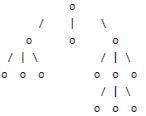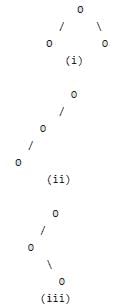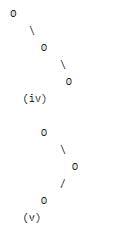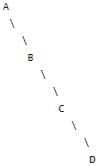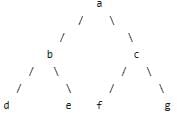Test: Trees- 1 - Computer Science Engineering (CSE) MCQ
20 Questions MCQ Test GATE Computer Science Engineering(CSE) 2025 Mock Test Series - Test: Trees- 1
If arity of operators is fixed, then which of the following notations can be used to parse expressions without parentheses?
(a) Infix Notation (Inorder traversal of a expression tree)
(b) Postfix Notation (Postorder traversal of a expression tree)
(c) Prefix Notation (Preorder traversal of a expression tree)
(a) Infix Notation (Inorder traversal of a expression tree)
(b) Postfix Notation (Postorder traversal of a expression tree)
(c) Prefix Notation (Preorder traversal of a expression tree)
Level of a node is distance from root to that node. For example, level of root is 1 and levels of left and right children of root is 2. The maximum number of nodes on level i of a binary tree is ____.
In the following answers, the operator '^' indicates power.
In the following answers, the operator '^' indicates power.
In a complete k-ary tree, every internal node has exactly k children or no child. The number of leaves in such a tree with n internal nodes is:
The maximum number of binary trees that can be formed with three unlabeled nodes is:
The number of leaf nodes in a rooted tree of n nodes, with each node having 0 or 3 children is:
A weight-balanced tree is a binary tree in which for each node. The number of nodes in the left sub tree is at least half and at most twice the number of nodes in the right sub tree. The maximum possible height (number of nodes on the path from the root to the farthest leaf) of such a tree on n nodes is best described by which of the following?
A complete n-ary tree is a tree in which each node has n children or no children. Let I be the number of internal nodes and L be the number of leaves in a complete n-ary tree. If L = 41, and I = 10, what is the value of n?
The height of a binary tree is the maximum number of edges in any root to leaf path. The maximum number of nodes in a binary tree of height h is:
A scheme for storing binary trees in an array X is as follows. Indexing of X starts at 1 instead of 0. the root is stored at X[1]. For a node stored at X[i], the left child, if any, is stored in X[2i] and the right child, if any, in X[2i+1]. To be able to store any binary tree on n vertices the minimum size of X should be.
Postorder traversal of a given binary search tree, T produces the following sequence of keys 10, 9, 23, 22, 27, 25, 15, 50, 95, 60, 40, 29 Which one of the following sequences of keys can be the result of an in-order traversal of the tree T?
Consider the following nested representation of binary trees: (X Y Z) indicates Y and Z are the left and right sub stress, respectively, of node X. Note that Y and Z may be NULL, or further nested. Which of the following represents a valid binary tree?
Consider a node X in a Binary Tree. Given that X has two children, let Y be Inorder successor of X. Which of the following is true about Y?
In a binary tree with n nodes, every node has an odd number of descendants. Every node is considered to be its own descendant. What is the number of nodes in the tree that have exactly one child?
The inorder and preorder traversal of a binary tree are d b e a f c g and a b d e c f g, respectively. The postorder traversal of the binary tree is:
The height of a tree is the length of the longest root-to-leaf path in it. The maximum and minimum number of nodes in a binary tree of height 5 are:
A binary tree T has 20 leaves. The number of nodes in T having two children is
Consider a complete binary tree where the left and the right subtrees of the root are max-heaps. The lower bound for the number of operations to convert the tree to a heap is
An array of integers of size n can be converted into a heap by adjusting the heaps rooted at each internal node of the complete binary tree starting at the node ⌊(n – 1) /2⌋, and doing this adjustment up to the root node (root node is at index 0) in the order ⌊(n – 1)/2⌋, ⌊(n – 3)/ 2⌋, ….., 0. The time required to construct a heap in this manner is:
What are the main applications of tree data structure?
1) Manipulate hierarchical data.
2) Make information easy to search (see tree traversal).
3) Manipulate sorted lists of data.
4) Router algorithms.
5) Form of a multi-stage decision-making, like Chess Game.
6) As a workflow for compositing digital images for visual effects
|
55 docs|215 tests
|
|
55 docs|215 tests
|







